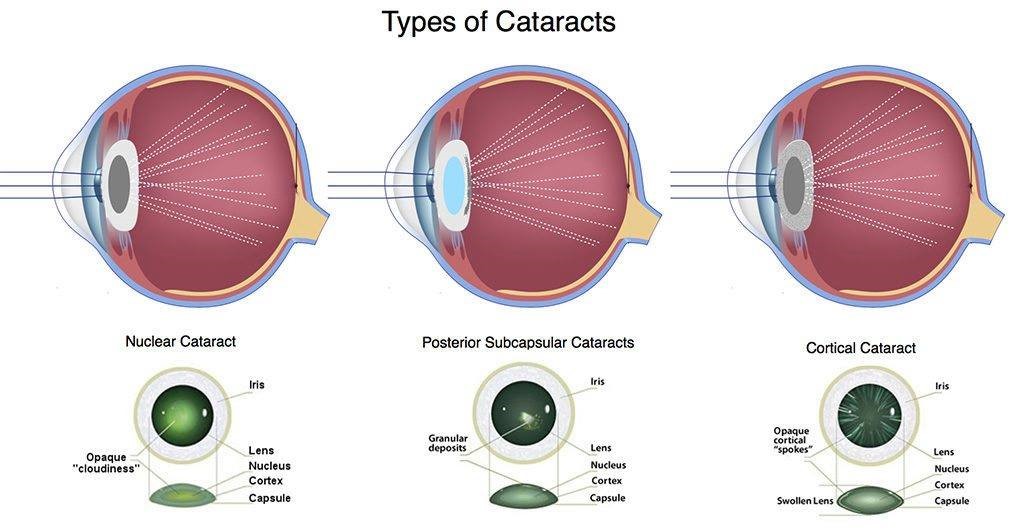Causes of posterior subcapsular cataract
Posterior subcapsular (PSC) cataract is the granular lens opacity within the posterior capsule at the back of the lens. PSC cataract is often located centrally and causes poor vision, especially during near work. To focus at a near object, the eyes accommodate, the pupils constrict, the light entering the eyes is concentrated to the centre of the lens where PSC cataract is located. The opacity is lens cause scattering of light and reduce the focus of image. PSC cataract also cause light sensitivity and glares where vision is poorer under bright condition. Headlights may interfere with vision while driving at night.
Causes
Long term steroid use
The cataract induced by long term steroid use are mostly PSC cataract. Corticosteroids prevents the differentiation of lens epithelial cells into lens fibre at the lens equator. The lens epithelial cells then migrate to and converge at the posterior pole without differentiation. PSC cataract is formed. Another explanation is glucocorticoids form covalent bonds to the lens proteins in the natural lens of the eye. The structure of the lens protein is disrupted and is no longer stable. Oxidation and other reactions occur, leading to cataract formation.
Intraocular inflammation
Cataracts developed in people with anterior uveitis are often PSC cataract. For instance, iridocyclitis. Studies showed increased aqueous flare value (sensitive marker of intraocular inflammation) in formation of PSC cataract. Proinflammatory cytokines produced by activated macrophages during intraocular inflammation has the potential to initiate the posterior migration of lens epithelial cells to form PSC cataract
High exposure to UV rays
Sunlight is the main source of ultraviolet (UV) radiation. 95% of UV rays that reach the ground are UVA rays while the remaining 5% are UVB rays. Long term outdoor activities like farming, renovation and construction works result in high exposure to the UVA and UVB rays. Those rays will be absorbed by the natural lens in our eyes to prevent harm to retina (back of the eye). High absorption of the UV light causes formation of more free radicals in the lens. The free radicals alter the structure of the lens protein, causing oxidative stress. The protein in the lens clumps up and thickens, forming opacity that block the light from passing through it. When the opacity is at the back of the lens, PSC cataract is formed. Lacking of awareness in UV protection among Malaysians increase the risk of PSC cataract. Examples of UV protection are wearing UV protection sunglasses and hats in outdoor.
Aging
Age related PSC cataract has an onset of age 55 years old. It causes focal reduction in refractive index of lens and vacuoles formation in lens at the early stages. The lens epithelial cells then migrate from the lens equator to the posterior pole. Those cells converge at the posterior pole to form a bladder-like fibres and then produce a new basement membrane that cause scattering of light within the lens.
Other ocular problems
PSC cataracts can be associated with high myopia, retinitis pigmentosa and diabetes. People with high degree of near-sightedness (myopia) has increasing length of eyeball (increasing axial length) which prevents the transport of nutrients to the back of the lens. Another explanation is that increasingly longer eye ball damage the light sensitive cells at the back of the eye (retina), which accompanied by various conditions, including cataract. Studies found that pathogenesis of the retinitis pigmentosa is associated with chronic ocular inflammation. Diabetic people have higher blood glucose level. When the glucose enters the lens cells through aqueous humour for lens metabolism. The glucose is metabolized to form sorbitol that accumulate in the lens and cause the lens to swell. The refractive index of the lens reduces and cause the vision to be blurred. The cataract is built up in the lens. Diabetes more commonly causes development of nuclear and cortical cataract. Study showed that diabetes is associated with progression of PSC cataracts.
Conclusion
In order to prevent development of PSC cataract, the causative factors should be avoided or reduced in daily life. Among the self-prevention steps, UV protection is the most effective and easily available in the market. UV protection wrap-over sunglasses reduce glare and filters 99 to 100% of UV rays. Selection of sunglasses should emphasize on UV protection, comfort and absence of colour distortion. The lenses should be large enough to shield the eyes from most angles and preferably wrap-over the face. There are also fit-over sunglasses that can be worn over the prescription spectacles. UV protection anti-reflective lens coating, transition lenses and photochromic lenses can be the alternative option. UV protection anti-reflective coatings can be added to the back of your spectacles lenses to filter UV rays reflected off sidewalks and windows. Transition lenses and photochromic lenses darkens under bright light and lighten up under dim light. Transition lenses is darker in tint, faster in darkening and is more favourable for drivers. Wide-brim hat and umbrella, along with sunglasses, provide extra protection by reducing amount of UV ray reaching the eyes. The above UV protection methods also reduce glare and light sensitivity for people with PSC cataract to maintain clear vision indoor and outdoor. If you have high demand of outdoor work or work that has long-term exposure to the sunlight, feel free to contact Mata Clinic & Optometrist for further enquiries.




Recent Comments